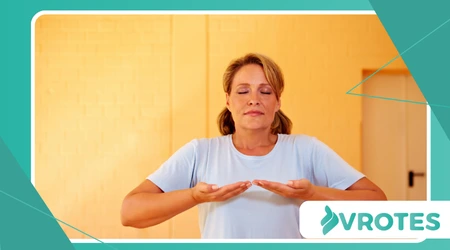Proven Breathing Techniques to Calm Menopause Anxiety

proven breathing techniques to calm menopause anxiety. The journey through menopause often brings a host of changes, some expected, others surprisingly challenging.
Among these, anxiety can emerge as a particularly disruptive companion, casting a shadow over daily life. But what if a simple, accessible tool, always at your disposal, could help quiet this internal storm?
We’re talking about the power of your breath, and specifically, proven breathing techniques to calm menopause anxiety.
The fluctuating hormones of perimenopause and menopause can significantly impact the nervous system, leading to heightened stress responses.
This isn’t just about feeling a bit more worried; it can manifest as heart palpitations, sleeplessness, irritability, and a pervasive sense of unease.
Traditional approaches often involve medication or therapy, which are undeniably valuable.
Yet, integrating complementary practices can offer immediate relief and foster long-term resilience. Breathing exercises fit this bill perfectly.
These techniques don’t just offer a temporary distraction. They actively engage the vagus nerve, a critical component of the parasympathetic nervous system.
Activating this nerve helps shift your body from “fight or flight” to “rest and digest.”
This physiological shift reduces heart rate, lowers blood pressure, and calms the mind.
Imagine a skilled conductor bringing an orchestra back into harmony after a cacophony. Your breath can act as that conductor.
Chronic stress during menopause can exacerbate other symptoms, creating a vicious cycle.
Better managing anxiety can, in turn, alleviate hot flashes and improve sleep quality. It’s a holistic approach to well-being.
Learning to control your breath gives you a sense of agency. It empowers you to respond to anxiety rather than react impulsively.
This control is invaluable during a time when many changes feel outside your influence.
The Science Behind Calming Breaths
Our breath is intrinsically linked to our autonomic nervous system. When we are stressed or anxious, our breathing becomes shallow and rapid. This signals danger to our brains.
Conversely, deep, slow breathing sends a message of safety. This deliberate action downregulates the stress response. It’s a direct line to your internal calm.
The vagus nerve, often called the “wandering nerve,” extends from the brainstem to the abdomen.
It plays a crucial role in regulating mood, digestion, and heart rate. Conscious breathing stimulates this nerve.
Stimulating the vagus nerve enhances vagal tone. A higher vagal tone means your body can recover more quickly from stress. Think of it as building your internal resilience muscles.
Research consistently supports the efficacy of controlled breathing.
A 2023 review published in Frontiers in Psychology highlighted how diaphragmatic breathing significantly reduces anxiety and improves mood across various populations, including those experiencing hormonal fluctuations.
This scientific backing provides a strong foundation for why these techniques are so effective. They’re not just anecdotal; they’re evidence-based strategies.
Practical Proven Breathing Techniques to Calm Menopause Anxiety
Let’s dive into some specific exercises you can easily incorporate into your daily routine. Consistency is key, even just a few minutes a day can make a big difference.

Diaphragmatic Breathing (Belly Breathing)
This is foundational for stress reduction. Lie down or sit comfortably. Place one hand on your chest, the other on your belly. Inhale slowly through your nose, feeling your belly rise.
See how interesting: How to Track Hormone Patterns to Predict Symptom Flare‑Ups
Your chest should remain relatively still. Exhale slowly through pursed lips, feeling your belly fall. Focus on making your exhalation longer than your inhalation.
Repeat this for 5-10 minutes. This technique helps engage your diaphragm fully. It brings more oxygen into your system.
4-7-8 Breathing
Developed by Dr. Andrew Weil, this technique is incredibly effective for quickly reducing anxiety. Empty your lungs completely. Inhale quietly through your nose for a count of four.
Hold your breath for a count of seven. Exhale completely through your mouth, making a “whoosh” sound, for a count of eight. Repeat this cycle three more times.
This powerful technique can even aid in falling asleep. It’s a quick reset for your nervous system.
Box Breathing
Often used by Navy SEALs, this method helps calm the nervous system and improve focus. Exhale all the air from your lungs. Inhale slowly for a count of four.
Hold your breath for a count of four. Exhale slowly for a count of four. Hold your breath (lungs empty) for a count of four.
Repeat this sequence several times. It creates a rhythmic pattern that anchors your attention. It breaks the cycle of anxious thoughts.
Integrating Breathing into Your Life
Making these techniques a consistent part of your routine is crucial. Don’t wait until anxiety strikes. Incorporate them proactively.
Daily Rituals
Start your day with five minutes of diaphragmatic breathing. This sets a calm tone for the hours ahead. End your day with 4-7-8 breathing to prepare for restful sleep.
During stressful moments, take a mindful pause. Step away from what you’re doing and practice a few rounds of box breathing. This can prevent anxiety from escalating.
++ A Complete Guide to Menopause-Related Dry Skin and Hydration Tips
Consider setting reminders on your phone. A gentle chime can prompt you to take a “breath break.” This builds a habit effortlessly.
Mindful Movement
Pairing breathing with gentle movement can enhance its effects. Yoga, Tai Chi, and even walking can become opportunities for mindful breathing. Synchronize your breath with your steps.
For example, when walking, inhale for four steps and exhale for six. This makes exercise a moving meditation. It amplifies the calming benefits.

The Power of Practice
Think of these exercises like building a muscle. The more you practice, the stronger your ability to manage anxiety becomes. Consistency yields cumulative benefits.
Initially, it might feel awkward or difficult to focus. That’s perfectly normal.
With time and practice, these proven breathing techniques to calm menopause anxiety will become second nature.
Read here: Crystal Therapy for Emotional Well-Being in Menopause
Imagine a turbulent sea. When strong winds whip the waves into a frenzy, it feels overwhelming.
But if you can anchor your boat, even slightly, and wait for the storm to pass, you’ll find calm. Your breath is that anchor.
Beyond the Breath: A Holistic Approach
While breathing techniques are incredibly powerful, they are most effective as part of a broader strategy. Consider these complementary elements for comprehensive anxiety management during menopause.
| Lifestyle Factor | Impact on Anxiety |
| Regular Exercise | Releases endorphins, reduces stress hormones, improves sleep. |
| Balanced Diet | Stabilizes blood sugar, provides essential nutrients for brain health. |
| Adequate Sleep | Crucial for mood regulation and cognitive function. |
| Stress Management | Mindfulness, meditation, hobbies, limiting stressors. |
| Social Connection | Reduces feelings of isolation, provides support. |
| Professional Support | Therapy (CBT), hormone replacement therapy (HRT) if appropriate and discussed with a doctor. |
Engaging with a supportive community can also make a significant difference.
Sharing experiences with others going through similar challenges fosters a sense of belonging and reduces feelings of isolation. Don’t underestimate the power of connection.
Remember, menopause is a transition, not an illness.
Equipping yourself with effective tools like proven breathing techniques to calm menopause anxiety empowers you to navigate this phase with greater ease and confidence.
You deserve to feel calm and in control.
Unique and Shared Journey
The journey through menopause, while unique for every woman, often presents shared challenges, with anxiety being a prominent one.
The simple yet profound act of conscious breathing offers a powerful antidote.
By integrating proven breathing techniques to calm menopause anxiety into your daily life, you gain an invaluable tool for self-regulation and emotional resilience.
This isn’t just about coping; it’s about thriving. These techniques empower you to reclaim your peace, allowing you to experience this life stage with greater serenity and control.
Isn’t it time to embrace the calm that’s always within your reach?
Frequently asked questions
How quickly can I expect to see results from these breathing techniques for menopause anxiety?
Many women report feeling a sense of calm and reduced anxiety almost immediately after practicing these techniques.
However, consistent daily practice over a few weeks will yield more significant and lasting benefits as your body and mind learn to adopt these calmer responses more readily.
Think of it as building a muscle; consistent effort brings stronger results.
Can these breathing techniques replace medication for anxiety during menopause?
While these breathing techniques are powerful tools for managing anxiety, they should not necessarily replace prescribed medication without consulting your doctor.
They are an excellent complementary therapy that can significantly reduce symptoms and improve overall well-being.
Always discuss any changes to your treatment plan with a healthcare professional.
Are there any side effects to practicing these breathing exercises?
Generally, breathing exercises are safe and have no adverse side effects when performed correctly.
Some people might experience lightheadedness initially if they hyperventilate or breathe too rapidly.
If this occurs, simply return to your normal breathing pattern and resume the exercise more slowly. Listen to your body and adjust as needed.
How often should I practice these breathing techniques?
For optimal results, aim to practice these techniques for 5-10 minutes, two to three times a day. You can also use them reactively whenever you feel a surge of anxiety.
Consistency is more important than duration; even short, regular sessions are highly beneficial.
Can these breathing techniques help with other menopause symptoms like hot flashes or sleep disturbances?
Yes, absolutely! Anxiety and stress often exacerbate other menopause symptoms.
By calming your nervous system through proven breathing techniques, you can indirectly reduce the frequency and intensity of hot flashes, improve sleep quality, and even alleviate mood swings.
It’s a holistic approach that benefits multiple aspects of menopausal well-being.
